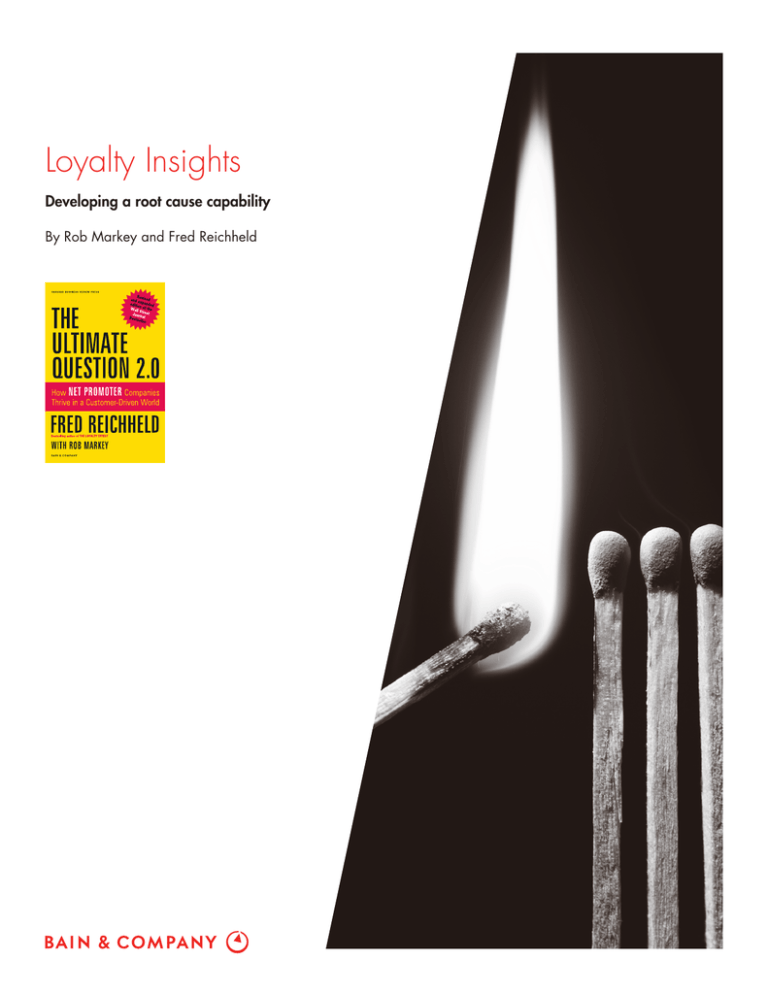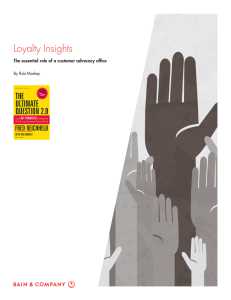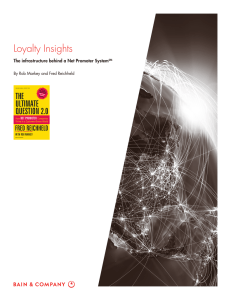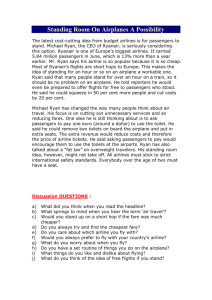
Loyalty Insights
Developing a root cause capability
By Rob Markey and Fred Reichheld
Fred Reichheld and Rob Markey are authors of the bestseller The Ultimate
Question 2.0: How Net Promoter Companies Thrive in a Customer-Driven World.
Markey is a partner and director in Bain & Company’s New York office and
leads the firm’s Global Customer Strategy and Marketing practice. Reichheld
is a Fellow at Bain & Company. He is the bestselling author of three other
books on loyalty published by Harvard Business Review Press, including The
Loyalty Effect, Loyalty Rules! and The Ultimate Question, as well as numerous
articles published in Harvard Business Review.
Copyright © 2012 Bain & Company, Inc. All rights reserved.
Developing a root cause capability
Airlines regularly survey flyers, asking how likely respondents would be to recommend each of the carriers they
use to friends and colleagues. They also probe the reasons for different ratings. Of course, many passengers give
certain airlines poor ratings because they believe those airlines perform significantly worse than competitors in
on-time performance—more delays, more cancellations and so on. But in many cases, flight data shows that the
gap is far less than customers seem to think. What’s really going on?
A large insurance company was struggling with persistently low Net Promoter® scores (NPS)1 among customers
who had recently filed claims. Trying to identify the reasons, the company heard a common theme: Claims agents
weren’t demonstrating sufficient empathy. Typical responses included “They made me feel like a criminal” and “I
had to prove everything over and over.” Concerned, the insurer launched a series of training initiatives to improve
its agents’ listening skills and help them learn to show empathy. But nothing seemed to help—customers were
still unhappy. Why were the efforts fruitless?
Virtually every large enterprise devotes significant
time and resources to surveying its customers about
their attitudes, behaviors and intentions regarding the
company’s products or services. Usually it’s the marketing department that sponsors these surveys, and
usually the surveys contain endless numbers of questions. There’s a reason for the length, of course: The
goal is to pinpoint exactly what customers most like
and most dislike.
The Net Promoter system’s process takes a different
approach. NPS companies typically ask their customers
just two questions: How likely would you be to recommend this company [or product] to friends and colleagues?
and What is the primary reason for your rating? Some of
these surveys, like the airline one described above, are
“top down”—anonymous studies that compare ratings
among competitors. Others, like the insurance company’s, are “bottom up,” meaning internal surveys
of a company’s own customers, often conducted right
after a transaction. (To learn more about the difference, see www.netpromotersystem.com/top-bottom.)
In both cases, the questionnaire is short so response
rates are usually high. The company learns exactly
what’s on customers’ minds, expressed in their own
words. The processes generate a steady stream of data
that frontline supervisors and employees can use to
improve their performance.
That’s why the typical hotel questionnaire, for instance,
asks about the reception desk, the bell captain, the
concierge, the air conditioning, the lighting, the pillows,
the bed, the minibar, the turn-down service, the shower
and on and on, usually 30 or 40 individual items in
all. And what happens? Most customers just toss the
card back on the dresser, never filling it out, and the
hotel never learns what is on those customers’ minds.
As for the minority who do fill out the cards, respondents find themselves limited to the categories established by the hotel’s survey designers. Suppose that
what you really value is the hotel’s location and what
you really hate is the noise of the garbage trucks out
back at six AM, and neither of those items appears on
the long list of questions? There isn’t a survey in the
world—at least not one that a reasonable person would
answer—that can cover every conceivable reason for a
customer’s reactions to a product or service.
But a Net Promoter system poses a challenge to its
practitioners. Customers can always articulate what’s
bothering them or what they most like about a company.
But they don’t always know the full story behind their
own feelings. So companies can rarely stop with customers’ expressed comments. The insurer, for instance,
heard the complaints—lack of empathy—and quickly
decided that it should help agents show more empathy.
But things didn’t improve.
1
Developing a root cause capability
This is where root cause analysis enters the picture.
sible for shaping the customer’s experience almost
always results in better, more enduring solutions, whether
those teams consist of call center agents, web designers, product developers, pricing managers or sales
directors. Digging for root causes is a skill to be developed throughout the organization, not reserved just for
specialists in a central department.
The five whys
Root cause analysis in business goes back to the Total
Quality movement and ultimately to the Toyota Production System. Toyota—and, later, many other companies—trained production analysts to ask why a defect
appeared and to keep asking why until they had identified a root cause. It wasn’t enough to note that a
machined part was loose because the hole it fit into
was too big. Why had the operator drilled the wrong
size hole? Had he chosen the wrong bit, and if so, why?
Was the bit stored in the wrong bin? Was it mislabeled?
If so, why? The process of asking at least five whys
gave companies the ability to attack not just the symptoms
of poor quality, such as a loose part, but the underlying root cause —the core reason behind what happened.
Look once more at the two real-world examples at the
beginning of this article.
The unhappy passengers. A team at one airline that
saw a discrepancy between the company’s actual ontime performance and customer perceptions began
their search for the root cause by studying customers’
responses. Among the many customers upset about
travel delays and cancellations, some felt they didn’t
receive appropriate compensation. An obvious first response for any airline is, maybe we should offer more
compensation and improve our on-time performance.
But both solutions would cost millions of dollars. Better on-time performance, for instance, requires spare
planes, backup crews, extra mechanics on duty and
so on.
It’s much the same with customer feedback. If a customer
says that the product’s price is too high, for instance,
that’s not the end point; it’s merely the starting point
for further investigation. Why does she feel that way?
Is it because she doesn’t make use of the full set of
benefits the product offers? Is it because the most important benefits are buried in a sea of other, less valuable features? Is it because the company has sold the
wrong product to this particular customer? If a company ends its research with the customer’s statement,
“the price is too high,” it essentially has only two choices,
neither one satisfactory. It can lower the price to make
the customer happy, hurting its margin. Or it can keep
the price where it is and risk driving the customer away.
Asking the five whys leads to a larger set of possible
solutions. It also helps a company focus on solutions
that will be more likely to influence customers’ subsequent behavior and attitudes.
Closer analysis, however, yielded different insights. How
the airline handled delays seemed more important
than the delay itself (see figure). In fact, delayed passengers mostly fell into one of two groups: those who
felt that the airline’s communication about the delay had
been terrific and those who thought it was terrible.
Passengers who thought the airline had communicated
well gave it far higher scores than those who did not.
In fact, the scores from passengers who experienced
long delays but good communication were about the
same as scores from passengers who experienced only
minor delays, but thought the communication had
been lousy.
And while it’s tempting to hand off the job of digging
for root causes to specialists at corporate headquarters—
after all, they have the experience, skills and time available to do the job well—that’s usually not the best
solution. Engaging the teams that are directly respon-
The team could now investigate each group further.
Why did some people believe that communication
had been so good? It turned out that someone in au-
2
Developing a root cause capability
thority, usually the pilot, had addressed them clearly
and explicitly about what he or she knew and had shown
empathy with the passengers’ plight. Asking why that
didn’t happen all the time, the airline found that its
procedures were poorly defined: No one was quite
sure who was supposed to address the passengers.
Some pilots took the initiative to do so, others did not.
Moreover, pilots had differing levels of communications skills. Some made passengers feel a lot better
and others did not.
be perceived as lying—but as a result they waited for
“just five more minutes,” over and over. Unfortunately,
their good intentions resulted in prolonged silence
that contributed to passenger anger.
As for the group that felt communication had been
poor, many respondents said they had been given conflicting information, and thus believed that someone
had lied to them. Again, the airline’s team asked why.
They found that gate agents and other employees were
often using different and uncoordinated computer systems, which provided different information.
The unhappy callers. The story was similar at the
insurance company. Training the claims agents in
empathy and listening skills made some difference—
but not much. The reason: a set of policies and procedures that undermined even the most empathetic agents.
For example, the company required customers to fill
out a lot of paperwork. It required them to sign claims
requests in front of a notary. And since the company’s
systems did not provide each representative with the
claimant’s full story, reps were forced to ask for the
Once the “why?” questions were asked and answered,
the airline could take corrective actions, including
synchronizing information systems, clarifying communications procedures and training pilots in communications skills.
They also discovered that gate agents were reluctant
to give out incomplete information—they didn’t want to
Figure: The way a delay or cancellation is handled has a bigger impact on passengers than the event itself
What bothered you most about the DELAY?
What bothered you most about the CANCELLATION?
Net Promoter score
Net Promoter score
100%
80
30
80
21
46
60
40
100%
10
60
30
32
29
20
8
33
29
87
40
70
41
20
4
17
43
50
22
0
NPS
0
Delay
itself
Length of
delay
The way it
was handled
24%
11%
60%
NPS
Promoter
Passive
SM
SM
Sources: Survey BottomUp Delays, December 2011; Bain analysis
3
Cancellation
itself
Length of
delay
The way it
was handled
14%
33%
83%
Detractor
SM
Developing a root cause capability
the unsynchronized computer systems, for
instance, it had good reason to believe that
many passengers were indeed receiving conflicting information.
same information on every call, making customers
feel that they were being interrogated. Why were the
systems so limited? Well, rapid recall of notes from a
prior call would require a system upgrade, and the
company had never believed such an upgrade was
worth the expense.
3. Proposing actions. At this point the team can
assign a value to addressing each root cause.
What would fixing this problem cost? What
would it be worth? That leads to a list of proposed actions.
These root causes—which implicitly identified a set of
potential solutions—didn’t appear until the company
asked a series of “why?” questions.
Systematic root cause identification:
Four steps
4. Institutionalizing the feedback. The team then
loops back to key individuals in the company,
putting a feedback mechanism in place to ensure consistent attention to root causes. The
airline, for instance, created a measurement
system that gave employees faster feedback on
their adherence to best-practice behaviors, along
with direct feedback on what customers were
saying through the Net Promoter surveys.
Over time, leading Net Promoter companies have
developed procedures that embed root cause analysis
deep into their operations and processes. The procedures typically follow a four-step sequence.
1.
2.
1
Identifying most likely potential causes from
feedback data. Customer responses indicate
proximate causes of their satisfaction or dissatisfaction with your products or services.
Company employees can add their insights
into possible root causes, essentially creating
a list of hypotheses about what lies behind the
responses. The team can then rank-order the
list by likely importance.
The development of this capability—the root cause
discipline—is a key part of creating a powerful Net
Promoter system. It takes time and resources, but the
payoff is substantial. It enables a company not just to
hear the voice of the customer, but also to push deep into
its internal operations to learn exactly where it is doing
things right and where it is doing things wrong. The
company thus learns why it creates promoters among
some customers and detractors among others, and it
can take action to increase the former and decrease the
latter. That ability lies at the very heart of the true customer-centric enterprise.
Asking the “why?” questions. Team members
then begin pursuing the five whys for the topranked causes, thus deepening and enriching
their list of hypotheses. They assemble operational data that will help them test and validate
possible causes. When the airline uncovered
Net Promoter® and NPS® are registered trademarks of Bain & Company, Inc., Fred Reichheld and Satmetrix Systems, Inc.
4
Shared Ambit ion, True Results
Bain & Company is the management consulting firm that the world’s business leaders come
to when they want results.
Bain advises clients on strategy, operations, technology, organization, private equity and mergers and acquisitions.
We develop practical, customized insights that clients act on and transfer skills that make change stick. Founded
in 1973, Bain has 48 offices in 31 countries, and our deep expertise and client roster cross every industry and
economic sector. Our clients have outperformed the stock market 4 to 1.
What sets us apart
We believe a consulting firm should be more than an adviser. So we put ourselves in our clients’ shoes, selling
outcomes, not projects. We align our incentives with our clients’ by linking our fees to their results and collaborate
to unlock the full potential of their business. Our Results Delivery® process builds our clients’ capabilities, and
our True North values mean we do the right thing for our clients, people and communities—always.
For more information, visit www.netpromotersystem.com
For more information about Bain & Company, visit www.bain.com









